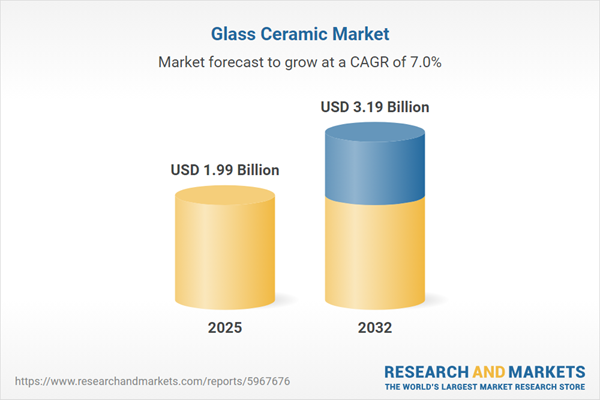Speak directly to the analyst to clarify any post sales queries you may have.
Glass ceramic materials are reshaping modern manufacturing and infrastructure strategies. Their unique attributes—thermal stability, mechanical strength, and adaptability—continue to unlock new potential across advanced industrial sectors. Senior leaders tracking the glass ceramic market can anticipate technology shifts, leverage opportunity, and prepare for complex regulatory challenges.
Market Snapshot: Glass Ceramic Market Size and Dynamics
The global glass ceramic market is on a steep growth trajectory, with a projected increase in size from USD 1.86 billion in 2024 to USD 1.99 billion in 2025 and an estimated reach of USD 3.19 billion by 2032. Forecasts indicate a compound annual growth rate (CAGR) of 6.96%, reflecting strong demand from user industries, continuous investment in high-precision manufacturing, and rapid adoption of innovative production technologies. The market evolves in tandem with advancements in technology, policy changes, and shifting customer needs, encouraging capital allocation across global supply chains. Advanced manufacturing and electronics sectors drive much of this activity, pushing for resilience and expansion in an increasingly competitive landscape.
Scope & Segmentation
This report equips senior executives with actionable segmentation analysis and opportunity insights, supporting agile decision-making as industry requirements evolve. Segmentation includes the following core market dimensions:
- End User Industries: Aerospace & Defense, Automotive, Construction (covering cladding, facades, countertops, flooring, tiles), Consumer Goods, Electronics & Electrical (including display panels, substrates, insulators, and semiconductors), and Healthcare; each sector demands customized glass ceramic applications, driving differentiation and technological advancement.
- Product Types: Opaque (blue, green, red, white) and Transparent (clear low iron, standard, bronze, gray tinted) enable solutions for industrial and consumer markets, balancing performance and aesthetic requirements.
- Applications: Cookware & Bakeware, Industrial Equipment, Kitchenware, Lighting Fixtures, Tableware & Serveware; these categories leverage material versatility for both domestic and professional uses, facilitating innovation in everyday and premium products.
- Compositions: Lithium Alumino Silicate, Magnesium Alumino Silicate, Zirconium Alumino Silicate; these compositions deliver distinct properties, enabling tailored chemical resistance and mechanical strength across critical and routine applications.
- Regions: Detailed analysis covers the Americas (including United States, Canada, Mexico, Brazil, Argentina, Chile, Colombia, Peru), Europe, Middle East & Africa (with focus markets such as UK, Germany, France, Russia, Italy, Spain, Netherlands, Sweden, Poland, Switzerland, UAE, Saudi Arabia, Qatar, Turkey, Israel, South Africa, Nigeria, Egypt, Kenya), and Asia-Pacific (China, India, Japan, Australia, South Korea, Indonesia, Thailand, Malaysia, Singapore, Taiwan), clarifying regulatory trends, supply chain priorities, and centres of innovation.
- Notable Companies: SCHOTT AG, Corning Incorporated, Kyocera Corporation, NGK Insulators Ltd., Morgan Advanced Materials Plc, Saint-Gobain S.A., CoorsTek Inc., CeramTec GmbH, Ferro Corporation, Plansee SE; these industry leaders continue to influence R&D investment, technology adoption, and sourcing environments through a focus on scalable solutions and capacity enhancement.
Key Takeaways for Senior Decision-Makers
- Engineered glass ceramic solutions enhance reliability in mission-critical settings, from aerospace advancements to long-term infrastructure projects.
- Processes such as additive manufacturing and sol-gel techniques drive rapid product customization, ensuring timely responses to evolving market demands.
- Raw material price volatility and changing geopolitical factors require robust sourcing strategies and agile supply chain planning at both tactical and strategic levels.
- Sustainability initiatives—integrating recycled materials and advanced waste management—are becoming integral to operational excellence and competitive advantage.
- Industry 4.0 technologies, such as real-time analytics and digitalized supply chain tools, empower manufacturers to react efficiently to market or regulatory change.
- Differentiated regional approaches remain essential as Asia-Pacific accelerates manufacturing and innovation, while EMEA and Americas adapt to diverse regulatory and market contexts.
Tariff Impact: Navigating Market Shifts in the US Glass Ceramic Segment
Tariff changes set for 2025 will impact cost structures for U.S. glass ceramic producers and importers. Many companies are actively reassessing supplier relationships and moving toward domestic and regional sourcing models. Simultaneously, investment is directed into alternative manufacturing methods and negotiation of new supplier agreements. Maintaining cost competitiveness, resilience, and operational continuity depends on effective management of these tariff-influenced changes within procurement and supply chain strategies.
Methodology & Data Sources
Findings in this report are backed by a blend of quantitative analysis of global market data and tariff trends, enhanced by qualitative insights from industry veterans and technical experts. An independent panel validated the data to ensure alignment with executive requirements and sector realities.
Why This Report Matters
- Offers practical guidance for navigating technology-driven and regulatory market shifts within the glass ceramic industry.
- Enables management teams to adjust product and sourcing strategies proactively in response to new competitive, regulatory, and regional factors.
- Supports benchmarking by highlighting opportunities for growth, innovation, and operational improvement within each analyzed region.
Conclusion
Advanced technologies and dynamic regulations are driving transformation in the glass ceramic market. Executive leaders prioritizing innovation, resilient supply chains, and sustainability initiatives will sustain relevance and competitive strength as market conditions evolve.
Additional Product Information:
- Purchase of this report includes 1 year online access with quarterly updates.
- This report can be updated on request. Please contact our Customer Experience team using the Ask a Question widget on our website.
Table of Contents
3. Executive Summary
4. Market Overview
7. Cumulative Impact of Artificial Intelligence 2025
Companies Mentioned
The companies profiled in this Glass Ceramic market report include:- SCHOTT AG
- Corning Incorporated
- Kyocera Corporation
- NGK Insulators, Ltd.
- Morgan Advanced Materials Plc
- Saint-Gobain S.A.
- CoorsTek, Inc.
- CeramTec GmbH
- Ferro Corporation
- Plansee SE
Table Information
| Report Attribute | Details |
|---|---|
| No. of Pages | 190 |
| Published | October 2025 |
| Forecast Period | 2025 - 2032 |
| Estimated Market Value ( USD | $ 1.99 Billion |
| Forecasted Market Value ( USD | $ 3.19 Billion |
| Compound Annual Growth Rate | 6.9% |
| Regions Covered | Global |
| No. of Companies Mentioned | 11 |









